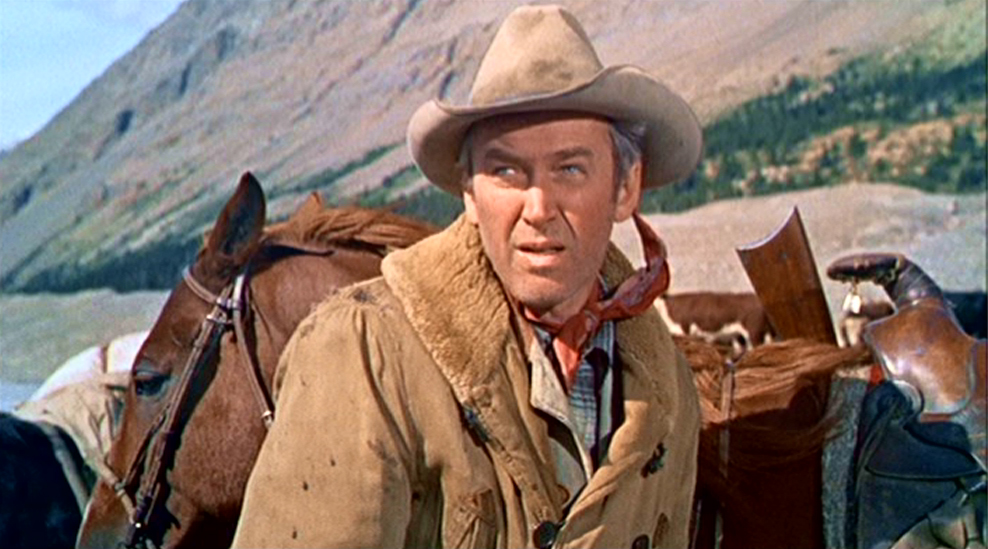# 18
BLOOD ON THE MOON (RKO, 1948)
DIRECTOR: Robert Wise; PRODUCER: Sid Rogell; WRITERS: Lillie Hayward, Harold Shumate and Luke Short from novel by Short; CINEMATOGRAPHER: Nicholas Masuraca
CAST: Robert Mitchum, Barbara Bel Geddes, Robert Preston, Walter Brennan, Phyllis Thaxter, Tom Tully, Frank Faylen, Clifton Young, Tom Tyler, Harry Carey, Jr., Richard Powers (Tom Keene), Bud Osborne, Robert Bray, Ben Corbett, Chris Pin-Martin, Hal Taliaferro, Iron Eyes Cody
JIM GARRY (Robert Mitchum): "Shotten, Reardon, and me. Hired gunmen."
TATE RILING (Robert Preston): "Shotten and Reardon get paid in gold eagles. You get paid in thousands."
JIM GARRY: "Yeah. Only difference between us is the price."
The source of this film is another range war story, the specialty of the popular and prolific Western novelist, Luke Short. This time it is cattlemen vs. nesters. Mitchum is a drifter caught between opposing sides, and the bad guy is his old pal, Robert Preston.
Though the plot is pretty standard the director and cast pull it off with aplomb.
One of the best things about the film is the atmospheric photography of Masaruca. In fact, the film could be classified as a noir Western, no surprise given the backgrounds of Wise, Mitchum, and Masaruca, since all three had made their reputations in noir dramas.
The exteriors are filmed around Sedona, Arizona, known for its red rock topography, making it one of the most scenic areas in the world. Since the movie is filmed in black-and-white, it does not take advantage of those gorgeous colors as other Westerns do, but it does utilize the rugged nature of the landscape to great effect.
B-Western aficionados can appreciate the film for several reasons:
B-Western aficionados can appreciate the film for several reasons:
Mitchum had gained his start in films portraying outlaws in the Hopalong Cassidy series, before RKO attempted to turn him into a B-Western star in his own right (the studio abandoned the plan, however, and elevated him into major productions, after his critically acclaimed supporting role in THE STORY OF G.I. JOE (UA, 1945), ironically, the only role for which he received an Academy Award nomination; second, Tom Keene, now billed as Richard Powers, had been the studio's very first B-Western star in the early 30's, but was now reduced to character roles, often as a villain, at the very same studio where he had once starred; Third, Tom Tyler, former B-Western hero, portrays a hired gunman; and fourth, it was good to see Bud Osborne, stage driver or heavy in literally hundreds of B-Westerns, receive the opportunity to portray a good guy for once and even receive the chance to deliver several lines of dialogue.
Barbara Bel Geddes would later become best known as the Ewing matriarch, Miss Ellie, in the long-running prime time soap opera, DALLAS.
Brennan, cast against type, gives a restrained performance as one of the nesters that is a dramatic departure from his usual bombastic, flamboyant and/or comedic Western roles.
BLOOD ON THE MOON was Robert Wise's first Western and first A-budget movie and despite its success he is on record as saying that he did not enjoy directing Westerns.
 | ||
| Tom Keene, RKO B-Western star in early 30's |
 |
| Tom Tyler in a scene from one his silent Westerns |
Barbara Bel Geddes would later become best known as the Ewing matriarch, Miss Ellie, in the long-running prime time soap opera, DALLAS.
 | |
| Barbara Bel Geddes and Robert Mitchum |
Brennan, cast against type, gives a restrained performance as one of the nesters that is a dramatic departure from his usual bombastic, flamboyant and/or comedic Western roles.
BLOOD ON THE MOON was Robert Wise's first Western and first A-budget movie and despite its success he is on record as saying that he did not enjoy directing Westerns.
In fact, he would direct only two more in his long and successful career. He became best-known for directing two of Hollywood's most acclaimed musicals: WEST SIDE STORY (1961) and THE SOUND OF MUSIC (1965).
******
REVIEWS
"...a tough and complicated suspense movie with a disappointing plot but a wonderful flavor of the real West....It's superbly produced...and [is characterized] by flawless performances; Mitchum, Preston, Bel Geddes, and Tully are outstanding....the movie is exciting and excellent, widely regarded as a classic Western." -- Brian Garfield in Western Films
"One of [Wise's] best films and one of the best scripted Westerns of the forties." -- William K. Everson in A Pictorial History of the Western Film
"[It] has a sound, sensible story to tell and, besides, it is well acted. Robert Mitchum carries the burden of the film and his acting is superior all the way." -- New York Times
"BLOOD ON THE MOON is a terse, tightly-drawn Western drama. There's none of the formula approach to its story telling. Picture captures the crisp style used by Luke Short in writing his Western novels." -- Variety
******
REVIEWS
"...a tough and complicated suspense movie with a disappointing plot but a wonderful flavor of the real West....It's superbly produced...and [is characterized] by flawless performances; Mitchum, Preston, Bel Geddes, and Tully are outstanding....the movie is exciting and excellent, widely regarded as a classic Western." -- Brian Garfield in Western Films
"One of [Wise's] best films and one of the best scripted Westerns of the forties." -- William K. Everson in A Pictorial History of the Western Film
"[It] has a sound, sensible story to tell and, besides, it is well acted. Robert Mitchum carries the burden of the film and his acting is superior all the way." -- New York Times
"BLOOD ON THE MOON is a terse, tightly-drawn Western drama. There's none of the formula approach to its story telling. Picture captures the crisp style used by Luke Short in writing his Western novels." -- Variety












